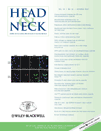Modified type III cordectomy to improve voice outcomes after transoral laser microsurgery for early glottic canser
Abstract
Background
We proposed a modified type III cordectomy for the treatment of early glottic cancer that removed the upper part of the vocalis muscle to improve glottic closure and voice outcomes.
Methods
Twenty-two patients with early glottic cancer underwent type III cordectomy, including 9 classical (proposed by European Laryngological Society) and 13 modified resections. Multidimensional voice evaluations were performed.
Results
Voice parameters including GRBAS (overall grade [G], roughness of the voice [R], breathiness [B], asthenicity [A], and strain [S]), jitter, shimmer, noise-to-harmonic ratio, maximum phonation time, voice handicap index-functional, physical, and total scores were better in modified resection. Eleven patients (85%) had complete glottic closure in modified resection and 3 (33%) in classical resection (p = .026). Only 2 patients had tumor recurrence, 1 (8%) in the modified resection and 1 (11%) in the classical resection group (p = 1.000).
Conclusions
Modified type III cordectomy proved to be an oncologically safe method. The voice outcomes were better than those in patients who underwent classical type III cordectomy. © 2011 Wiley Periodicals, Inc. Head Neck, 2011




